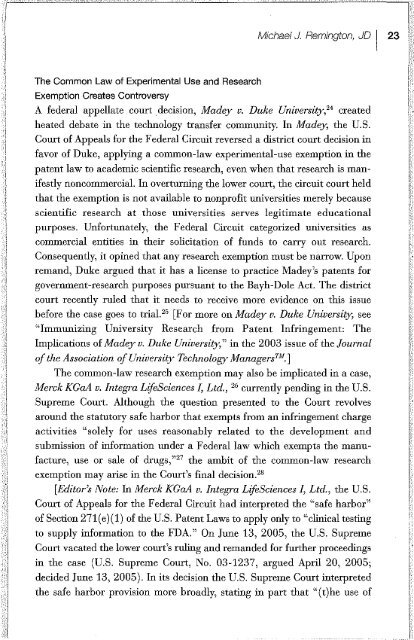~Iri,n - Bayhdolecentral
~Iri,n - Bayhdolecentral
~Iri,n - Bayhdolecentral
Create successful ePaper yourself
Turn your PDF publications into a flip-book with our unique Google optimized e-Paper software.
The Common Law of Experimental Use and Research<br />
Exemption Creates Controversy<br />
Michael J. Remington, JD I 23<br />
A federal appellate court decision, Madey v. Duke Unioersity." created<br />
heated debate in the technology transfer community. In Madey, the U.S.<br />
Court of Appeals for the Federal Circuit reversed a district court decision in<br />
favor of Duke, applying a common-law experimental-use exemption in the<br />
patent law to academic scientific research, even when that research is man<br />
ifestly noncommercial. In overturning the lower court, the circuit court held<br />
that the exemption is not available to nonprofit universities merely because<br />
scientific research at those universities serves legitimate educational<br />
purposes. Unfortunately, the Federal Circuit categorized universities as<br />
commercial entities in their solicitation of funds to carry out research.<br />
Consequently, it opined that any research exemption must be narrow. Upon<br />
remand, Duke argued that it has a license to practice Madey's patents for<br />
government-research purposes pursuant to the Bayh-Dole Act. The district<br />
court recently ruled that it needs to receive more evidence on this issue<br />
before the case goes to trial." [For more on Madey v. Duke University, see<br />
"Immunizing University Research from Patent Infringement: The<br />
Implications of Madey v. Duke University," in the 2003 issue of the Journal<br />
ofthe Association ofUniversity Technology Managers.]<br />
The common-law research exemption may also be implicated in a case,<br />
Merck KGaA v. Integra LifeSciences I, Ltd., 26 currendy pending in the U.S.<br />
Supreme Court. Although the question presented to the Court revolves<br />
around the statutory safe harbor that exempts from an infringement charge<br />
activities '(solely for uses reasonably related to the development and<br />
submission of information under a Federal law which exempts the manu<br />
facture, use or sale of drugs,"27 the ambit of the common-law research<br />
exemption may arise in the Court's final decision."<br />
[Editor's Note: In Merck KGaA v. Integra LifeSciences I, Ltd., the U.S.<br />
Court of Appeals for the Federal Circuit had interpreted the "safe harbor"<br />
of Section 271 (e)(1) of the U.S. Patent Laws to apply only to "clinical testing<br />
to snpply information to the FDA." On June 13, 2005, the U.S. Supreme<br />
Conrt vacated the lower court's ruling and remanded for further proceedings<br />
in the case (U.S. Supreme Court, No. 03-1237, argued April 20, 2005;<br />
decided June 13, 2005). In its decision the U.S. Snpreme Court interpreted<br />
the safe harbor provision more broadly, stating in part that "[tjhe use of
















